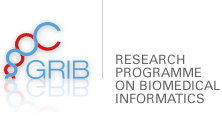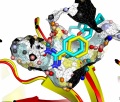
2/5/2012
Identified 115 proteins that would allow designing new generation anti-cancer drugs; The new drugs would be more effective and with fewer side effects.
Researchers from the Chemogenomics Group of GRIB (IMIM/ UPF) have identified 115 proteins in silico (via computer simulation) that could be highly relevant to treat colon-rectal cancer, since they would make it possible to define the strategy to design new generation anti-cancer drugs. During the last years, it has been proven that drugs are not as selective as it was thought, and that they actually have an affinity for multiple biological targets. For this reason it is important to develop multi-target drugs, meaning drugs that are able to attack several targets simultaneously, that are more effective and with fewer side effects
One of the key aspects of the research in new cancer drugs is determining with what proteins the drug should interact, so as to destroy the tumour cells without affecting healthy ones. In this sense, the work presents a new strategy to identify proteins that are highly relevant in cancer. According to Jordi Mestres, the coordinator of the Chemogenomics Laboratory of the GRIB “The basis of this strategy is a list of molecules that, experimentally, have been proven to be significantly more toxic for tumour cells than for healthy ones and another list of molecules that are more toxic for healthy cells than for tumour ones. These two lists of molecules are computationally processed with a methodology that allows predicting those proteins for which each molecule will have an affinity, identifying potential biological targets to develop new anti-cancer drugs”.
The researchers’ contributions have been, more specifically, the prediction of proteins that interact with molecules that have experimentally shown a differential cytotoxicity, either for tumour cells or healthy ones. The larges efforts were made in experimental testing of 30,000 molecules and the logistical difficulty this entails. Overall, 119,520 cytotoxicity data were generated for both tumour and healthy cells. Once both groups of molecules with the highest differential cytotoxicity were identified, predicting those proteins with which they interacted was very effective thanks to a methodology that was originally developed by the same researchers participating in the study which then became the foundation of the Chemotargets spin-off (http://www.chemotargets.com).
This study is part of the doctoral theses of students Praveena Kuchipudi and Nikita Remez, from the GRIB, with the collaboration of Prof. Ferran Sanz, the director of the GRIB. It is framed within a project of the 6th European Framework Programme CancerGrid (ftp://ftp.cordis.europa.eu/pub/lifescihealth/docs/cancergrid.pdf), and was lead by the Hungarian company AMRI, that contributed its compound library (a collection of millions of compounds), and by testing them it was possible to identify molecules with a differential cytotoxicity.
Reference Article: “A Chemocentric Approach to the Identification of Cancer Targets”. Beáta Flachner, Zsolt Lörincz, Angelo Carotti, Orazio Nicolotti, Praveena Kuchipudi, Nikita Remez, Ferran Sanz, József Tóvári, Miklós J. Szabó, Béla Bertók, Sándor Cseh, Jordi Mestres, and György Dormán. PLoS ONE 2012, 7: e0035582. http://dx.plos.org/10.1371/journal.pone.0035582



